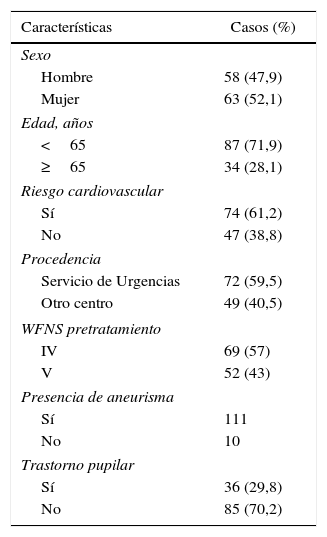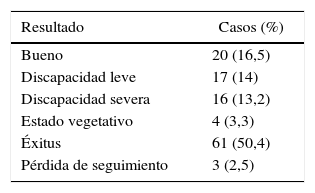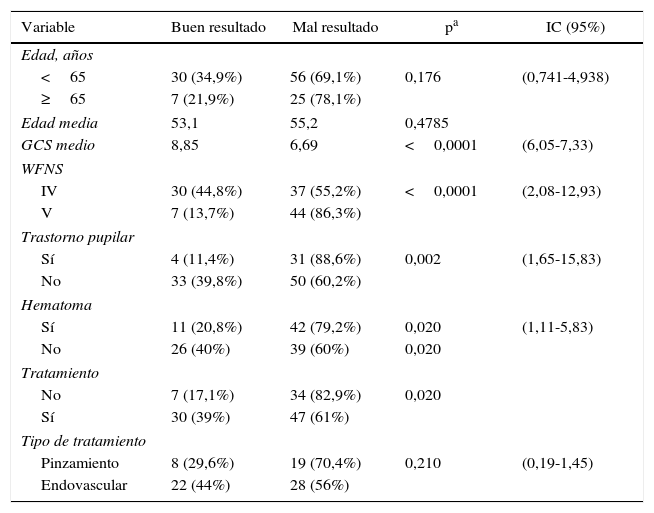Evaluar y predecir factores que influyan en el pronóstico y/o resultado clínico a los 6 meses de pacientes con hemorragia subaracnoidea espontánea, en grados iv y v de la World Federation of Neurosurgical Societies (WFNS).
Material y métodosEstudio retrospectivo de una serie consecutiva de 394 pacientes que ingresaron en nuestro hospital, con diagnóstico clínico y radiológico de hemorragia subaracnoidea espontánea, desde el 1 de enero de 1999 hasta el 30 de junio de 2009. Se seleccionaron 121 pacientes que reunían el criterio de estar en grado iv o v de la WFNS antes del tratamiento; se excluyeron 3 pacientes por pérdida de seguimiento. La variable resultado se evaluó a los 6 meses del evento mediante la Escala de Resultados de Glasgow. Se consideró un resultado estadísticamente significativo un valor de p<0,05.
ResultadosCiento veintiún pacientes se incluyeron en el análisis estadístico. La edad media de la serie fue de 54 años (14-92). Los pacientes que presentaban una puntuación en la Escala de Coma de Glasgow media inferior a 7 puntos (p<0,0001) y un grado de v (p<0,0001) en la escala de la WFNS pretratamiento, así como los que presentaban trastorno pupilar (p=0,002), mostraron un peor resultado clínico final; igualmente, los que asociaron hematoma intraparenquimatoso (p=0,020) y aquellos a los que no se les efectuó ningún tipo de tratamiento (p=0,020) también asociaron un mal resultado clínico final, siendo estos resultados estadísticamente significativos.
ConclusionesLos pacientes que ingresan con una gradación de v en la escala de la WFNS y/o presentan trastorno pupilar y/o hematoma intraparenquimatoso asocian un peor resultado clínico final.
To evaluate and predict factors influencing prognosis and/or clinical outcome at 6 months in patients with spontaneous subarachnoid haemorrhage, World Federation of Neurosurgical Societies (WFNS) grades iv and v.
Material and methodsThis was a retrospective study of a consecutive series of 394 patients admitted to our hospital with clinical and radiological diagnosis of spontaneous subarachnoid haemorrhage, from 1 January 1999 to 30 June 2009. We selected 121 patients who met the criteria of being in WFNS grades iv or v before treatment; 3 patients were excluded due to loss of tracking. The outcome variable was assessed 6 months after the event using the Glasgow Outcome Scale. A P value<.05 was considered statistically significant.
ResultsOne hundred and twenty-one patients were included in the statistical analysis. The average age of the patients in the series was 54 years (14-92). Patients who had a mean Glasgow Coma Scale lower than 7 points (P<.0001), those who were grade v (P<.0001) in the pre-treatment WFNS scale and those with pupillary disorder (P=.002) had a worse clinical outcome. Likewise, those with associated intraparenchymal hematoma (P=.020) and those not receiving any treatment (P=.020) were also associated with a poor clinical outcome. These results were statistically significant.
ConclusionsPatients admitted with a WFNS grade v and/or presenting pupil disorder and/or intraparenchymal hematoma were associated with worse clinical outcomes.
Article

If it is the first time you have accessed you can obtain your credentials by contacting Elsevier Spain in suscripciones@elsevier.com or by calling our Customer Service at902 88 87 40 if you are calling from Spain or at +34 932 418 800 (from 9 to 18h., GMT + 1) if you are calling outside of Spain.
If you already have your login data, please click here .
If you have forgotten your password you can you can recover it by clicking here and selecting the option ¿I have forgotten my password¿.









